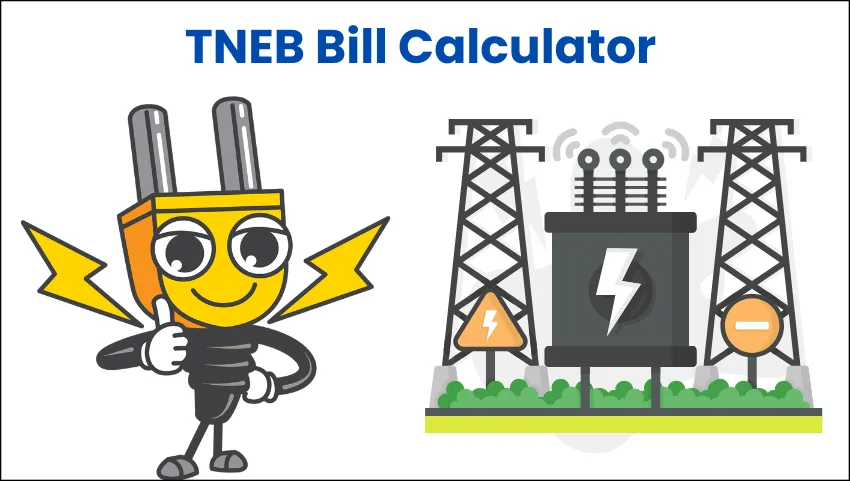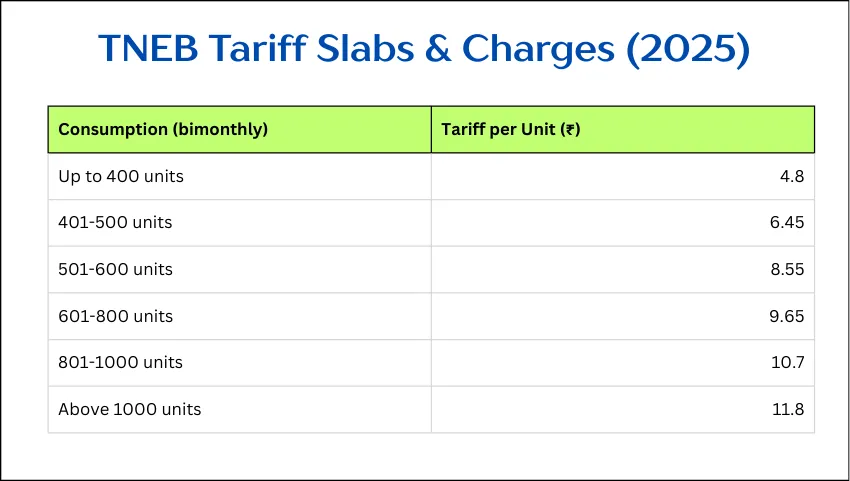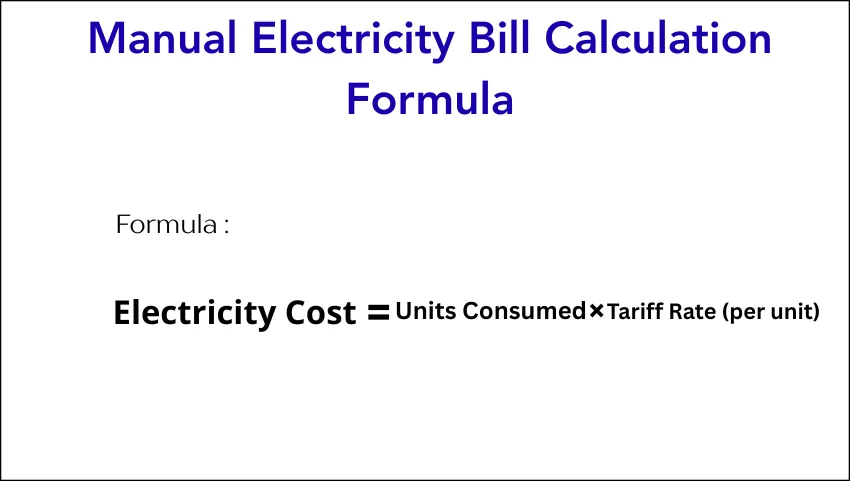TNEB Bill Calculator
Calculate your Tamil Nadu Electricity Board bill instantly
Bill Details
TNEB Tariff Rates (2024-25)
| Category | Units | Rate (₹/unit) | Fixed Charge |
|---|---|---|---|
| Domestic | 0-100 | ₹0 | ₹20/month |
| 101-200 | ₹2.25 | ||
| 201-500 | ₹4.60 | ||
| Above 500 | ₹6.60 | ||
| Commercial | All units | ₹7.50 | ₹100/month |
| Industrial HT | All units | ₹5.50 | ₹500/month |
The TNEB Bill Calculator is an online tool designed to help Tamil Nadu electricity consumers estimate their monthly or bimonthly electricity bills in a simple, transparent way. Whether for a home, business, or any other establishment, this calculator allows anyone to easily check their expected charges based on the number of units consumed.
What is the TNEB Bill Calculator?
The TNEB Bill Calculator is an online utility that allows users in Tamil Nadu to quickly estimate how much they will be charged for their electricity usage. By entering the total units consumed (as per meter reading), users can instantly view their expected bill, see a detailed charge breakdown, and plan or control future energy consumption.

- TNEB stands for Tamil Nadu Electricity Board.
- The tool works for domestic, commercial, industrial, and other connection types.
- The calculator is free and does not require login or registration.
Why Should Consumers Use the TNEB Bill Calculator?
- Easy Forecasting: Estimate the bill in advance to avoid surprises.
- Plan Budget: Manage family or business finances around expected electricity costs.
- Understand Bill Breakdown: See how much each slab or fee contributes to the final amount.
- Promote Energy Saving: Compare usage scenarios to spot chances for saving.
Important: For the latest official tariffs, visit the TANGEDCO or TNEB websites.
How Does the TNEB Bill Calculator Work?
Step-by-Step Usage
- Check Meter Reading:
- Note the current meter reading and subtract the previous meter reading to find total consumption (in units or kWh).
- Open the Calculator:
- Use a reliable website, such as tnebbillcalculator.
- Enter Units Consumed:
- Type the total units into the input box. Use only numbers; avoid letters or symbols.
- Some calculators have a virtual keypad for easy entry.
- Select Billing Cycle:
- Choose “Monthly” or “Bi-Monthly” as per your standard bill.
- Press Calculate:
- Click on the “Submit” or “Calculate” button.
- View Breakdown:
- Instantly see the estimated total, detailed bill breakdown (by slab), fixed charges, taxes, and subsidies (if any).
- Make Adjustments:
- Use Clear or Backspace to correct input or start a new calculation.
TNEB Tariff Slabs & Charges (2025)
The Tamil Nadu Electricity Board follows a slab-based tariff structure, meaning the charge per unit increases with higher consumption:

| Consumption (bimonthly) | Tariff per Unit (₹) |
|---|---|
| Up to 400 units | 4.80 |
| 401-500 units | 6.45 |
| 501-600 units | 8.55 |
| 601-800 units | 9.65 |
| 801-1000 units | 10.70 |
| Above 1000 units | 11.80 |
Note:
- Free units and subsidies may apply for certain categories, like for the first 100 units for domestic consumers.
- Additional charges: Fixed charges (e.g., ₹20 for domestic), electricity duty (e.g., 15%), taxes (e.g., 5%), and others may apply.
Example: TNEB Bill Calculation
Imagine: A user has consumed 550 units in the last 2 months (bi-monthly billing).
Breakdown:
- For the first 400 units: ₹4.80 x 400 = ₹1,920
- Next 100 units (401-500): ₹6.45 x 100 = ₹645
- Remaining 50 units (501-550): ₹8.55 x 50 = ₹427.5
Subtotal for energy: ₹1,920 + ₹645 + ₹427.5 = ₹2,992.5
Add fixed charges (e.g., ₹20), duty (e.g., 15% of energy charges), and taxes (e.g., 5%).
Let’s calculate:
- Fixed Charges: ₹20
- Duty: 15% × ₹2,992.5 = ₹448.88
- Taxes: 5% × ₹2,992.5 = ₹149.63
Total Bill ≈ ₹2,992.5 + ₹20 + ₹448.88 + ₹149.63 = ₹3,611.01
This is a general example. Always use the calculator and check official rates for the most accurate bill!
Key Features: TNEB Bill Calculator
- Instant Results: Get bills in seconds without manual math.
- Breakdown Display: View each tariff slab’s cost, plus all additional charges.
- Supports Multiple Categories: Domestic, commercial, industrial, public lighting, etc.
- Latest Tariff Rates : Updated as per the latest TNERC announcements (as of August 2025).
- Mobile-Friendly: Many calculators work great on mobiles/tablets.
- Data Saving: Some tools allow result download as a PDF/WhatsApp share.
Tips for Accurate Calculation
- Always enter actual meter readings for best results. Do not guess.
- Select the correct billing cycle (monthly or bimonthly).
- For business or industrial users, input contract load details if required.
- Use updated calculators that regularly sync with official TNEB tariffs.
Manual Bill Calculation Formula
Want to do your own calculation? The process is simple:

Formula: Electricity Cost = Units Consumed × Tariff Rate (per unit)
For a complete bill:
- Calculate energy charge as above, slab-by-slab.
- Add fixed charges, meter rent, duty, and taxes.
- Subtract subsidies (if eligible).
- Sum everything for the net payable.
Slab System Explained
In the slab system, units are divided as follows:
- First, the blocks (e.g., 0-400, 401-500, etc.) are charged at different rates.
- As total consumption increases, new slabs with higher rates apply.
Example:
- 390 units: All units charged at the lowest rate.
- 410 units: The first 400 at the lowest rate, the next 10 at the higher rate, and so on.
Energy Saving Tips for Lower Bills
- Switch to LED bulbs and energy-efficient appliances.
- Turn off unused devices and lights.
- Opt for fans instead of air conditioners when possible.
- Monitor high-consuming items (geyser, fridge, AC) and use them wisely.
- Regularly review bills to spot unusual spikes early.
Common Errors and Troubleshooting
- “Please enter a valid number of units.” Only numbers should be entered; avoid spaces or extra characters.
- Wrong billing cycle: Selecting ‘Monthly’ instead of ‘Bi-Monthly’ (or vice versa) can result in wrong calculations.
- Outdated calculators: Use tools updated as per the latest tariff announcements for accurate estimation.
Importance of Using Latest Tariff Information
Electricity tariffs change periodically as per TNERC and TNEB notifications. Always check for the latest update before calculating your bill. Reliable calculators will mention the last update date (e.g., “Rates as of August 2025”).
Frequently Asked Questions (FAQs)
What is the TNEB Bill Calculator?
The TNEB Bill Calculator is an online tool that helps users estimate their electricity bill in Tamil Nadu based on units consumed and the latest tariff rates.
Is the TNEB Bill Calculator free to use?
Yes, the calculator is completely free and does not require registration or any payment to use, whether on official or trusted third-party platforms.
What information do I need to use the calculator?
You will need your electricity meter reading (units consumed), connection type (domestic, commercial, etc.), and your billing cycle (monthly or bimonthly).
How are electricity charges calculated in Tamil Nadu?
Charges are determined slab-wise: higher consumption moves you to higher tariff rates per unit, plus fixed charges, duty, and any taxes.
Are the first 100 units free for every consumer?
The first 100 units are often free for eligible domestic connections, but this benefit may be subject to government policies and should be verified at the time of bill calculation.
Can I use the calculator to compare monthly and bimonthly bills?
Yes, select the respective billing cycle when entering data to see the difference in your bill estimate.
Conclusion
The TNEB Bill Calculator is an essential free tool for every electricity consumer in Tamil Nadu. It makes bill estimation fast, transparent, and accurate, helping users avoid surprises and better plan their finances. Simply input your units, view the breakdown, and explore different usage possibilities to optimize your monthly or bi-monthly spending.
Always rely on updated, official-calculator versions and cross-check with your physical bill for best accuracy. For more detailed information, users can visit TNEB’s official tariff page or trusted third-party calculators as listed above.
